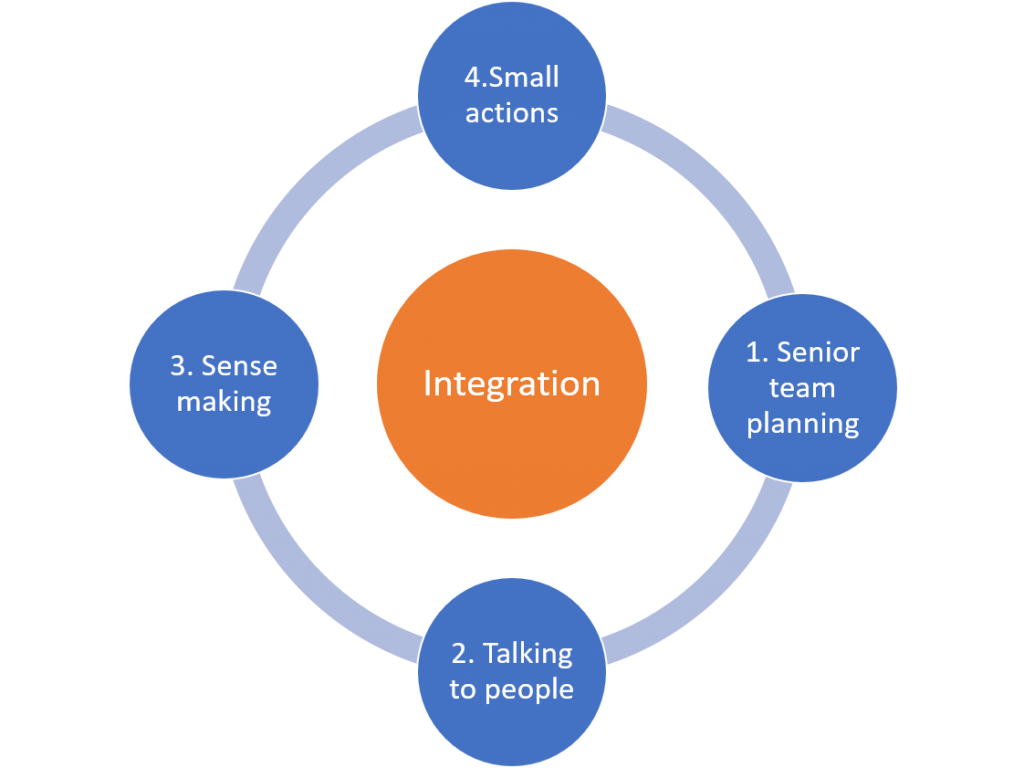This guide is for people who want to reduce the effect of bullying and incivility in teams, services, and organisations. It has been written to help people learn how to resist being silenced and to be constructively awkward as a way to keep thinking, feeling, and collaborating. This guide will disappoint those want a quick fix. They do not work and waste goodwill, which may already be depleted by years of oppressive behaviours being tolerated.
The guide describes five stages, that can be used by senior leadership to steady its progress through an intervention that never ever goes to plan and will have some people wishing they had never started.
If bullying and incivility has been a feature of the culture for a while, the senior leadership should not avoid its part in what is going on. Nor should it allow this acknowledgement to silence its authority and determination to improve things.
The ‘Leading the intervention’ position is crucial to the success of the whole project. The early stages of the intervention are disruptive, and reasons will emerge to stop. The later stages require vigilance to keep things going. Someone senior must be willing and able to observe how the stages are unfolding; keep people to task; help when required; acknowledge their own part in things; and insist on change.

Below is a summary of the stages. There is more detail via the links but remember this is a work in progress.
The evidence of the effects of bullying and incivility can be found here.
Overview of the 5 stages
- Senior team planning – This work begins and ends with the senior leadership. It will need to work through the implications for how it works and do this before ‘going public’. It needs to familiarise itself with the literature on bullying and incivility to build the case for change. It needs to understand what is likely to happen if it disrupts existing ways of getting work done; how people may react; how it will manage any reference to its own behaviour; what it will do if it becomes clear it has silenced and avoided issues and dilemmas in the name of expediency. The basic question for the leadership is: Do we care enough to navigate the uncertainty this work will lead us to before things feel better? If we do, how do we invite people to a conversation that is safe enough for them to speak about their work as experienced and for us to be able to listen? Stage 1 in detail here.
- Talking to people – Specific events will need to be discussed, if different ideas are to emerge about what triggers poor behaviours. The leadership must do this learning without assuming it must do something other than listen. This is the toughest stage to manage. If people think the senior team is serious, they will speak up. This is the Pandora’s Box moment. People will say things that reveal what they have put up with and potentially embarrass those who have not intervened or noticed poor behaviours. The senior team may notice its desire to shut things down and to offer simple explanations and interventions. They may notice that competing versions of the organisation’s culture emerge. Gaps open between what people want it to be like, assume it to be, tell people what it is; and how some people experience it. This is the stage of uncertainty and insight. People’s lived experience is no longer so opaque. It becomes data about how the inherent dilemmas and challenges of providing a well-governed and flexible service to individuals is being explicitly and covertly managed. Stage 2 in detail here.
- Sensemaking – A process to collaborate and make sense of the data to build a commitment to trying something different, is the leadership challenge of this stage. A safe enough space for people to talk openly is required, where the expression of the diversity of ideas is the purpose. Where people experience the co-creation of a tentative understanding of what is driving behaviour, making use of the research literature. Where the senior team is heard to encourage critical thinking and seen to intervene on the silencing of people. Where the senior team resists any desire to impose meaning and is prepared to talk about its own role in what is going on. Stage 3 in detail here.
- Small actions – Based on the work of stage 3 the leadership authorises a ‘working note’. A record of the best thinking about what people now think is going on and what will be tried to disrupt bullying and incivility. This stage is about learning how to disrupt the behaviours as they happen. The behaviours people publicly agree are not helpful to effective and efficient work. Learning how to move from bystander to asking a question now, and not waiting to ask it retrospectively. How to learn the difference between being clear and direct and just silencing someone; and how to resist being silenced. This is the stage of action learning, of experimenting, seeking ways of working that work in a context. Stage 4 in detail here.
- Integration – The senior team remains encouraging. Modelling a willingness to try new behaviours. Finding ways to help people build the skills and authority to resist being silenced and to be ‘constructively awkward’. The effort is made to integrate learning into existing activities (e.g. induction, leadership development programmes and HR processes). The work of the senior team during this stage is to keep the work going and to resist the fallacy that bullying and incivility go away. These unprofessional behaviours emerge if the ‘right’ conditions prevail. The senior team becomes the repository of learning about what these conditions are and remains alert to their emergence. The same level of scrutiny that is applied to the use of resources and money needs to be applied to the relational capital. Stage 5 in detail here.